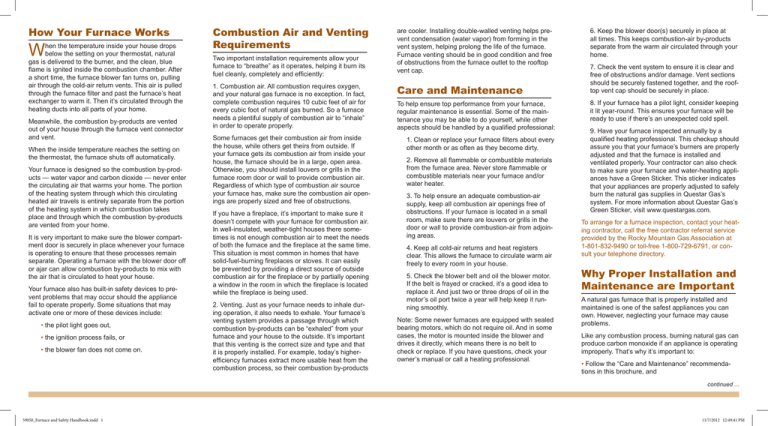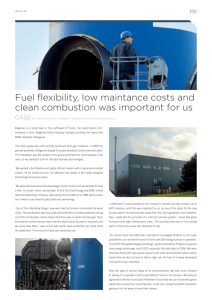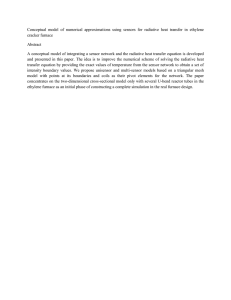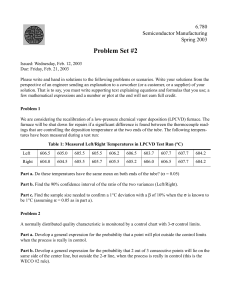How Your Furnace Works Combustion Air and Venting
advertisement

How Your Furnace Works W hen the temperature inside your house drops below the setting on your thermostat, natural gas is delivered to the burner, and the clean, blue flame is ignited inside the combustion chamber. After a short time, the furnace blower fan turns on, pulling air through the cold-air return vents. This air is pulled through the furnace filter and past the furnace’s heat exchanger to warm it. Then it’s circulated through the heating ducts into all parts of your home. Meanwhile, the combustion by-products are vented out of your house through the furnace vent connector and vent. When the inside temperature reaches the setting on the thermostat, the furnace shuts off automatically. Your furnace is designed so the combustion by-products — water vapor and carbon dioxide — never enter the circulating air that warms your home. The portion of the heating system through which this circulating heated air travels is entirely separate from the portion of the heating system in which combustion takes place and through which the combustion by-products are vented from your home. It is very important to make sure the blower compartment door is securely in place whenever your furnace is operating to ensure that these processes remain separate. Operating a furnace with the blower door off or ajar can allow combustion by-products to mix with the air that is circulated to heat your house. Your furnace also has built-in safety devices to prevent problems that may occur should the appliance fail to operate properly. Some situations that may activate one or more of these devices include: • the pilot light goes out, • the ignition process fails, or • the blower fan does not come on. Combustion Air and Venting Requirements Two important installation requirements allow your furnace to “breathe” as it operates, helping it burn its fuel cleanly, completely and efficiently: 1. Combustion air. All combustion requires oxygen, and your natural gas furnace is no exception. In fact, complete combustion requires 10 cubic feet of air for every cubic foot of natural gas burned. So a furnace needs a plentiful supply of combustion air to “inhale” in order to operate properly. Some furnaces get their combustion air from inside the house, while others get theirs from outside. If your furnace gets its combustion air from inside your house, the furnace should be in a large, open area. Otherwise, you should install louvers or grills in the furnace room door or wall to provide combustion air. Regardless of which type of combustion air source your furnace has, make sure the combustion air openings are properly sized and free of obstructions. If you have a fireplace, it’s important to make sure it doesn’t compete with your furnace for combustion air. In well-insulated, weather-tight houses there sometimes is not enough combustion air to meet the needs of both the furnace and the fireplace at the same time. This situation is most common in homes that have solid-fuel-burning fireplaces or stoves. It can easily be prevented by providing a direct source of outside combustion air for the fireplace or by partially opening a window in the room in which the fireplace is located while the fireplace is being used. 2. Venting. Just as your furnace needs to inhale during operation, it also needs to exhale. Your furnace’s venting system provides a passage through which combustion by-products can be “exhaled” from your furnace and your house to the outside. It’s important that this venting is the correct size and type and that it is properly installed. For example, today’s higherefficiency furnaces extract more usable heat from the combustion process, so their combustion by-products are cooler. Installing double-walled venting helps prevent condensation (water vapor) from forming in the vent system, helping prolong the life of the furnace. Furnace venting should be in good condition and free of obstructions from the furnace outlet to the rooftop vent cap. Care and Maintenance To help ensure top performance from your furnace, regular maintenance is essential. Some of the maintenance you may be able to do yourself, while other aspects should be handled by a qualified professional: 1. Clean or replace your furnace filters about every other month or as often as they become dirty. 2. Remove all flammable or combustible materials from the furnace area. Never store flammable or combustible materials near your furnace and/or water heater. 3. To help ensure an adequate combustion-air supply, keep all combustion air openings free of obstructions. If your furnace is located in a small room, make sure there are louvers or grills in the door or wall to provide combustion-air from adjoining areas. 4. Keep all cold-air returns and heat registers clear. This allows the furnace to circulate warm air freely to every room in your house. 5. Check the blower belt and oil the blower motor. If the belt is frayed or cracked, it’s a good idea to replace it. And just two or three drops of oil in the motor’s oil port twice a year will help keep it running smoothly. Note: Some newer furnaces are equipped with sealed bearing motors, which do not require oil. And in some cases, the motor is mounted inside the blower and drives it directly, which means there is no belt to check or replace. If you have questions, check your owner’s manual or call a heating professional. 6. Keep the blower door(s) securely in place at all times. This keeps combustion-air by-products separate from the warm air circulated through your home. 7. Check the vent system to ensure it is clear and free of obstructions and/or damage. Vent sections should be securely fastened together, and the rooftop vent cap should be securely in place. 8. If your furnace has a pilot light, consider keeping it lit year-round. This ensures your furnace will be ready to use if there’s an unexpected cold spell. 9. Have your furnace inspected annually by a qualified heating professional. This checkup should assure you that your furnace’s burners are properly adjusted and that the furnace is installed and ventilated properly. Your contractor can also check to make sure your furnace and water-heating appliances have a Green Sticker. This sticker indicates that your appliances are properly adjusted to safely burn the natural gas supplies in Questar Gas’s system. For more information about Questar Gas’s Green Sticker, visit www.questargas.com. To arrange for a furnace inspection, contact your heating contractor, call the free contractor referral service provided by the Rocky Mountain Gas Association at 1-801-832-9490 or toll-free 1-800-729-6791, or consult your telephone directory. Why Proper Installation and Maintenance are Important A natural gas furnace that is properly installed and maintained is one of the safest appliances you can own. However, neglecting your furnace may cause problems. Like any combustion process, burning natural gas can produce carbon monoxide if an appliance is operating improperly. That’s why it’s important to: • Follow the “Care and Maintenance” recommendations in this brochure, and continued ... 59050_Furnace and Safety Handbook.indd 1 11/7/2012 12:49:41 PM • Make sure your furnace is properly installed and has adequate combustion air and venting as described in your gas-appliance manufacturer’s installation instructions. (See also the “Combustion Air and Venting Requirements” section of this brochure.) Improperly adjusted appliances could result in natural gas not being burned completely, which may produce excess carbon monoxide. Under certain conditions, especially without proper ventilation, carbon monoxide could be released into your home. Carbon monoxide is an invisible, odorless and tasteless gas that is poisonous and can cause serious injury or, in extreme cases, even death. The symptoms of carbon monoxide poisoning are: • Persistent, severe headaches usually affecting more than one family member; • Nausea, vomiting and weakness; • The disappearance of symptoms when individuals leave the house. If you suspect the presence of carbon monoxide in your home based on symptoms exhibited by family members, open windows and/or doors, and evacuate all persons from your home to avoid continued exposure. Have your home inspected as soon as possible to identify and fix the source of the carbon monoxide. What to Do if You Smell Natural Gas In its natural state, natural gas generally is odorless. As a safety precaution, Questar Gas adds a pungent odorant to its gas so even the smallest leak is easy to detect. If you smell natural gas and the odor is persistent: • Do not light a flame, • Do not use your telephone or cell phone, and • Do not use light switches or electrically operated equipment. • Call Questar Gas for assistance. If you smell gas in your house, make this call from a neighbor’s house or other nearby telephone. Questar Gas will check for a gas leak at no additional charge to you. Questar Gas also has an excellent reputation for service reliability. That means you can expect to receive a continuous fuel supply, free of major service interruptions. • If you smell gas in your home or you can hear the sound of escaping gas, you may have a broken pipe. In that case, evacuate all persons from your home and call Questar Gas from another phone. When it comes to efficiency and value, it’s hard to beat natural gas. Of the energy produced from natural gas wells, 94 percent is delivered to users. By comparison, when coal is burned to generate electricity, only 28 percent of the original energy is delivered to customers. Natural gas’s high “source efficiency” helps make it an excellent energy value, which means lower heating costs for you. Fuel Facts Natural gas is one of the safest, most convenient, most efficient and environmentally clean energy sources for home heating. Natural gas enjoys an excellent safety record for several reasons: Furnace care and safety handbook Natural gas also is environmentally clean. When it is burned in a properly adjusted appliance, the only combustion by-products are heat, water vapor and carbon dioxide. • Natural gas is delivered through underground pipelines that undergo regular inspection for leaks. In fact, Questar Gas inspects its system for problems more often than regulations require. • Learn more about care & maintenance of your furnace • Natural gas is lighter than air. If natural gas is released, it rapidly dissipates into the atmosphere instead of “pooling” on or near the ground. This reduces the chance of accidental ignition should a leak occur. • In its natural state, natural gas is odorless as well as colorless and non-toxic. Local utilities such as Questar Gas add a non-toxic chemical odorant called mercaptan to supplies to make leaks easy to smell. However, there may be times when the smell of the odorant is weak or not present, even though there is a leak. If you suspect a leak for any reason, get to a safe place immediately and call the emergency number or 911. Call 1-800-3235517 for a free scratch-and-sniff odorant brochure if you don’t know the smell. SAFETY • What to do if you smell natural gas • What makes natural gas safe ® • Natural gas has a narrow combustion range. It burns only in a mixture of 5-15 percent natural gas and 85-95 percent air. In any other mixture of natural gas with air, it will not ignite. ® 59050 11/12 59050_Furnace and Safety Handbook.indd 2 11/7/2012 12:49:42 PM


